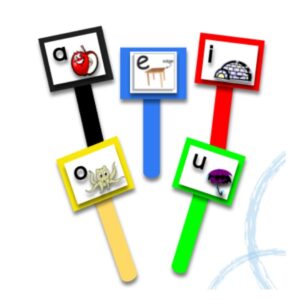Differentiating the Three-Part Drill
Using the Blue Flip Chart, Phoneme/Grapheme Card Pack, and Phoneme/Grapheme Chart, the Three-Part Drill and Vowel Intensive should be administered at least two to three times per week for general education classrooms or daily for intervention and Kindergarten. This review drill is key in helping your students master concepts.
Teachers can adapt the drill to ensure success for all students:
Visual:
- Pictures – Add picture cues to the teacher card pack. Make sure you use velcro on the front if you choose to add pictures. This will allow you to remove the picture cues when this scaffolding is no longer needed as well as beneficial when you get into higher concepts. C says /k/ as in cat, but C also says /s/ as in cent.
- Capital letters with visual cues
- Gestures – Visual cues for the short vowel sounds and voiced & unvoiced ‘th’
Auditory/Kinesthetic:
- Alternatives to the sand tray
- Screen & green crayon
- Technology (look for apps simulating drawing in the sand or colorful glow print). Some examples include: Art of Glow app, Sand Draw app, Fire Doodle app, Bubble Wrap app, and Whizzimo Letter Tiles
- Using paper, teachers may also provide letter formation support
Blending:
- Try onset-rime where you are only changing the onset, so students only have to change the initial sound when blending.
- I blend. We blend. You blend.
- Manipulate cards
- Show only VC syllables
- Change cards one at a time
Vowel Intensive:
- Vowel Sticks– Add pictures or visual cues

- Gestures – Cue short vowels to develop muscle memory
Remember, consistency in your instructional routines will support students’ development of mastery and automaticity in reading, spelling, and writing.
